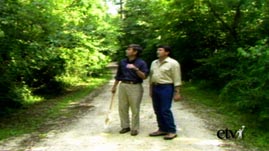Teachers' Domain - Digital Media for the Classroom and Professional Development
User: Preview

Source: NatureScene: “The Congaree Swamp”
The Congaree Swamp National Park is located on the floodplain between the Upper and Middle Coastal Plain provinces in South Carolina. Approximately 10 times a year, the Congaree River floods, providing essential nutrients for stimulating plant and wildlife growth in the swamp. In this video segment from NatureScene, learn about the identifying characteristics and preferred habitats of southeastern hardwoods as host Jim Welch and naturalist Rudy Mancke explore one of the best-preserved examples of a mature forested floodplain.
Trees can be identified based on their physical characteristics: leaves, fruit, and bark. Hardwood trees are deciduous, meaning they lose their leaves every year. Leaves can be opposite or alternate, and either simple or compound. Opposite leaves are diametrically opposed or symmetrical along a branch, while alternate leaves are not directly across from one another. Simple leaves appear by themselves on a stem, while compound leaves are grouped on a stem.
You can also identify a leaf type based on characteristics of its edge or margin. The leaf margin can be described as toothed, lobed, or entire. Leaves classified as entire leaves have smooth edges, such as Paw Paw leaves. Toothed leaves, as on dog hobble, have serrated edges. Lobed leaves, on the other hand, have wavy edges or deep indentations along the edges, as can be seen on red maple and sweet gum trees.
Some theories explain why plants have different kinds of leaves. For instance, it is thought that lobes enable elongation of leaves, allowing more exposure to sunlight for photosynthesis. Studies also show that plants with lobed and toothed leaves are capable of early season photosynthesis due to leaf structure. Additionally, scientists observe that waxy leaves facilitate photosynthesis by helping plants to retain moisture more easily than non-waxy leaves, which lose moisture more readily to the process of transpiration. Other findings are that toothed leaves act as an added protective measure, and that deciduous trees lose leaves to conserve energy in months with less sunlight.
Another way of discerning a tree species is to examine its habitat, such as whether it is found in sun or shade, and in wet or dry soil. Various hardwood species predominate in areas to which they are acclimated, based primarily on soil type and saturation. Some that thrive in the heavily-inundated floodplain of the Congaree are the bald cypress, water tupelo, water ash, and red maple. Several species are commonly found just above or alongside the floodplain, including sycamore, cottonwood, and hackberry. On higher bluffs that are better drained, various oaks tend to grow, including overcup oak and laurel oak, as well as green ash. Numerous other hardwood species predominate in the dry, sandy and well-drained areas, including cherrybark oak, water oak, holly, and sweetgum.
To learn more about the Congaree Swamp, check out Flood Plain and Higher Ground Habitats, Root Systems of Trees at the Congaree Swamp , Reptiles of the Congaree Swamp, and Primitive Insects of the Congaree Swamp.
For examples of other kinds of wetlands, see An Everglades Visit, The Value of Wetlands, and Hurricane Katrina: Wetland Destruction.
To learn how animals are classified according to certain physical characteristics and behaviors, check out Animal Classification Game.
For more information about the importance of diversity, see Amazon Rainforest or Biodiversity in the Dzangha-Sangha Rain Forest.
 Loading Standards
Loading Standards